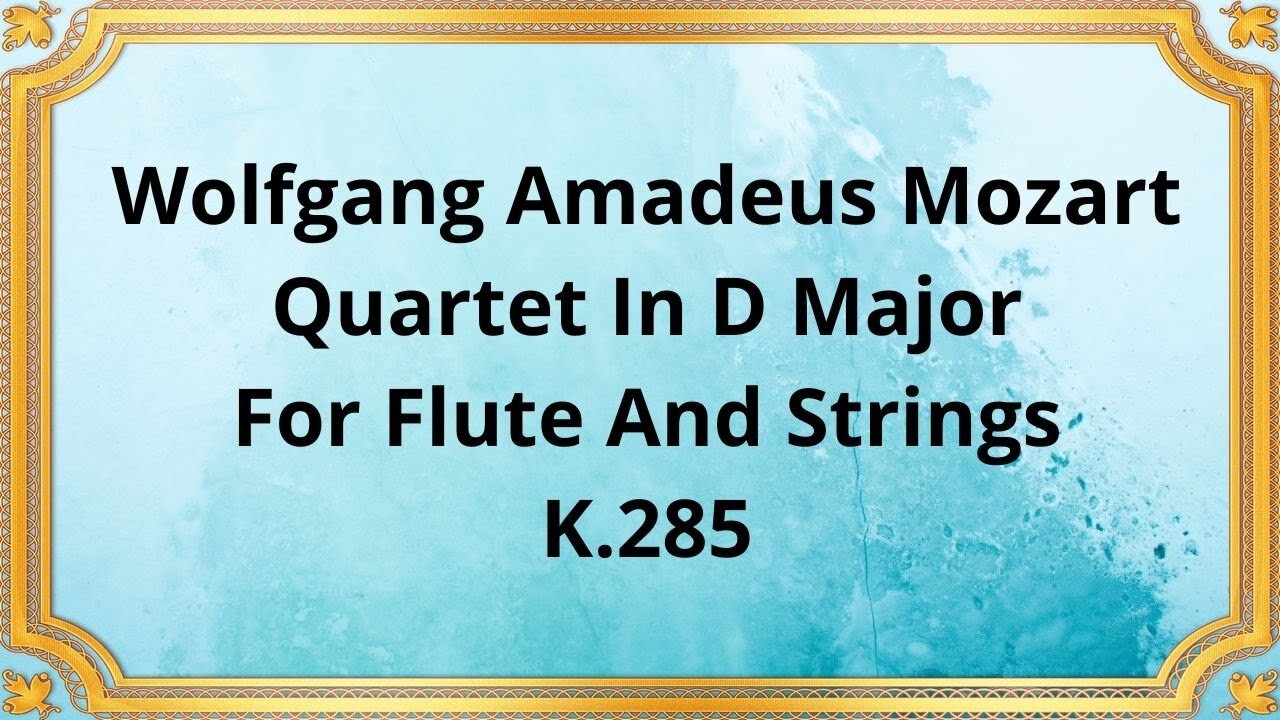Premium Only Content

Wolfgang Amadeus Mozart Quartet In D Major For Flute And Strings, K.285
#WolfgangAmadeusMozart #Quartet #Flute #Strings #DMajor #K285 #ClassicalMusic #MusicalComposition #ChamberMusic #MusicEnsemble #MusicPerformance #InstrumentalMusic #MusicAppreciation #ClassicalComposers #MusicianLife #MusicEducation #MusicCulture #MusicAppreciation #MusicLovers #MusicHistory #FluteMusic #StringInstruments #ChamberEnsemble #MusicReview
THE SALZBURG MOZART PLAYERS
Maria Michaela CUVAY, piano
Manfred CLEMENT, dons Kegnead KLEMM, flute
Joseph SCHROECKSNADEL, violin
Oskar HAGEN, viola
Joseph SCHNEIDER, cello
Wolfgang Amadeus Mozart, a name synonymous with classical music, gifted the world with a vast array of masterpieces. Among them, his Quartet in D Major for Flute and Strings, K.285, stands as a testament to his genius and ability to create enchanting compositions.
Mozart composed this quartet in 1777, during his time in Mannheim, Germany. The piece was written for a specific commission by Ferdinand De Jean, an accomplished amateur flutist. Mozart's intention was to showcase De Jean's virtuosity on the flute while also demonstrating his own compositional prowess. This quartet remains one of the most beloved flute chamber music compositions in the classical repertoire.
The Quartet in D Major for Flute and Strings is structured in three movements: Allegro, Adagio, and Rondeau. Mozart's choice of a quartet format, consisting of flute, violin, viola, and cello, allows for a rich and balanced sound. The flute takes on a prominent role, leading the melody and engaging in dialogue with the string instruments throughout the composition.
The Allegro movement introduces the listener to the lively and joyful nature of the piece. The Adagio movement offers a contrasting mood, with its melancholic and introspective melodies. Finally, the Rondeau movement brings a spirited and playful atmosphere, showcasing Mozart's ability to create intricate and engaging compositions.
Mozart's Quartet in D Major for Flute and Strings is a composition that evokes a range of emotions. The Allegro movement exudes energy and excitement, inviting listeners to embark on a musical journey filled with joy and exuberance. The Adagio movement, on the other hand, tugs at the heartstrings with its tender and emotive melodies, evoking a sense of longing and introspection. The Rondeau movement uplifts the spirit, offering a playful and lively dance-like quality.
Mozart's brilliant use of harmonies, dynamics, and expressive markings allows performers to bring out the nuances and emotions of the composition. The interplay between the flute and the string instruments creates a captivating dialogue, showcasing the virtuosity and synergy of the ensemble.
Mozart's Quartet in D Major for Flute and Strings, K.285, has remained a beloved piece in the classical music canon. Its timeless beauty and expressive nature continue to captivate audiences around the world. The composition serves as a testament to Mozart's ability to create music that transcends time, leaving a lasting impact on both performers and listeners.
Conclusion:
The Quartet in D Major for Flute and Strings, K.285, is a shining example of Mozart's brilliance and his ability to craft enchanting compositions. Through its three movements, it takes us on a journey of emotions, from exuberance to introspection and playfulness. This chamber music gem continues to be cherished by musicians and audiences alike, reminding us of the enduring power of Mozart's music and its ability to touch the depths of our souls.
You have the opportunity to support the channel:
https://destream.net/live/RadSiarAl/donate
https://www.buymeacoffee.com/6355radsiaral
-
 20:26
20:26
Classical music_Music Inspiration
1 month agoJohann Sebastian Bach Orchestral Suite No. 2 in B minor, BWV 1066
862 -
 LIVE
LIVE
Matt Kohrs
10 hours agoHUGE Earnings Beat, Inflation Data & New Record Highs || Live Trading Options & Futures
709 watching -
 LIVE
LIVE
Tucker Carlson
51 minutes agoTony Aguilar Details the War Crimes He’s Witnessing in Gaza
2,917 watching -
 LIVE
LIVE
Wendy Bell Radio
6 hours agoBurn Baby Burn
6,771 watching -
 LIVE
LIVE
JuicyJohns
1 hour ago🟢#1 REBIRTH PLAYER 10.2+ KD🟢$500 GIVEAWAY SATURDAY!
141 watching -
 LIVE
LIVE
LFA TV
11 hours agoLFA TV ALL DAY STREAM - THURSDAY 7/31/25
5,995 watching -
 1:02:45
1:02:45
Game On!
17 hours ago $1.55 earnedFootball is BACK! NFL Hall of Fame Game 2025
17.3K1 -
 LIVE
LIVE
FusedAegisTV
22 hours ago3rd Party Partner Showcase Nintendo Direct! REACTION 7.31.2025 | FusedAegis Presents
104 watching -
 13:30
13:30
WhaddoYouMeme
17 hours ago $3.59 earnedIt All Makes Sense Now
20.5K22 -
 2:00:05
2:00:05
Nick Freitas
16 hours agoIs Conservatism Dead?
22.8K23